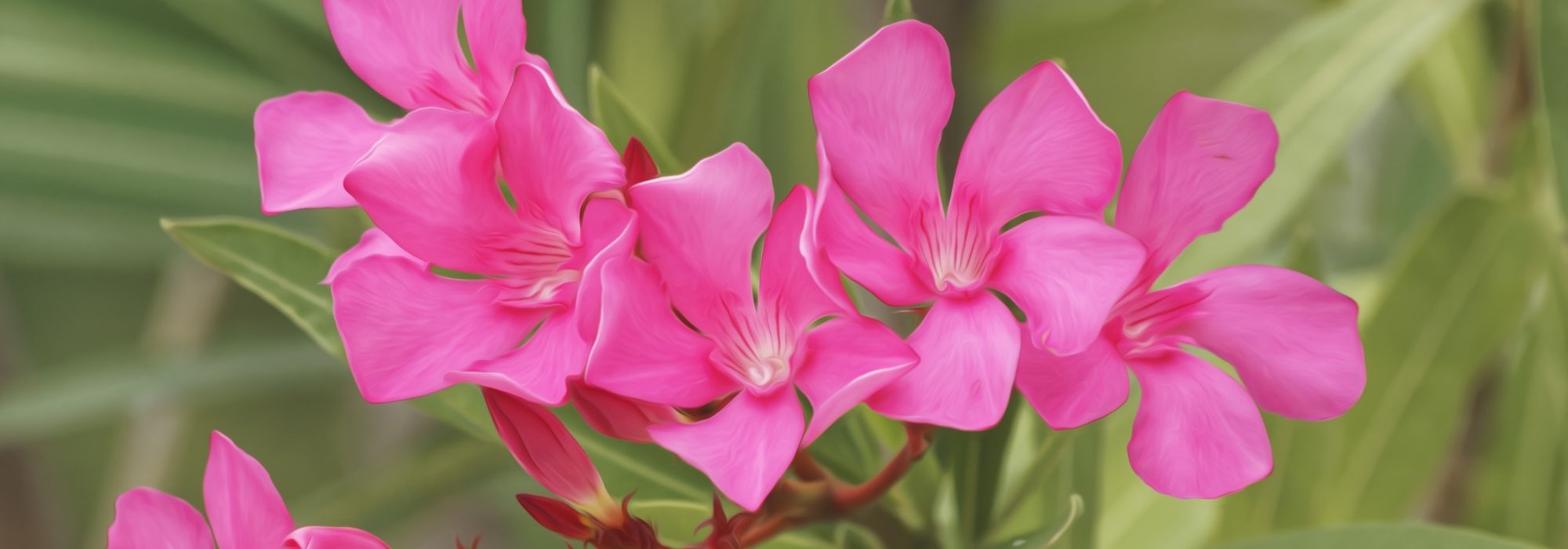
Oleander: planting, pruning and maintaining
Contents
Nerium oleander, commonly known as oleander, is a hardy evergreen shrub renowned for its beautiful, fragrant flowers. It thrives in warm climates and is often used in gardens and landscapes for its vibrant blooms and ability to tolerate drought. However, all parts of the plant are toxic if ingested, making it essential to handle with care.
- Oleander (Nerium oleander) is a fast-growing bush that is very easy to care for, typical of Mediterranean gardens.
- From June to September, it produces generous bouquets of flowers in a variety of intense colours, some of which are more or less fragrant.
- Its fairly massive rounded habit and dark green evergreen foliage provide a graphic appearance throughout the year.
- Drought-resistant and hardy for some varieties, it is often used in free-standing hedges, but its undeniable charm also makes it suitable for use as a specimen plant or in a large pot brought indoors for winter, to decorate a terrace.
A word from our expert
Oleander is one of the essential plants in the Mediterranean garden due to its long-lasting flowering. It can be grown both in pots and in the ground, offering a generous summer flowering in shades of pink, red, white, pale yellow, or salmon. The single or double flowers grouped in clusters adorn its evergreen foliage of dark green, recognizable by its elongated shape and the white latex that flows when broken. Oleander belongs to the Apocynaceae family, which is very different from the Lauraceae family that includes bay laurel, and it is used solely for ornamental purposes.
This bush forms a clump of upright stems that can reach 1 to 4 m high depending on the variety, but it can also be trained into a small tree on a stem with regular pruning. Maintaining it as a clump requires very little pruning; simply remove dead wood and dry fruits, as well as thin out occasionally. Very easy to care for, it makes an excellent greenhouse plant, planted in a container and is satisfied with a garden soil mixed with potting compost. It tolerates any type of soil and withstands drought very well, although it typically grows along waterways in its natural environment as well as in sea spray. The bush requires warmth and good sunlight to flower in the northern half of France.
The hardiest varieties can withstand temperatures as low as -16°C without any damage to the foliage, while others perish beyond -7°C. The varieties are rarely specified on oleander plants, which may seem unfortunate given the number of existing varieties. However, in the range offered on our site, the plants are selected for their colour, flowering ability, size, the appearance of single or double flowers, their fragrance, and their good level of hardiness. This does not prevent caution against the cold, especially when the bush is young!
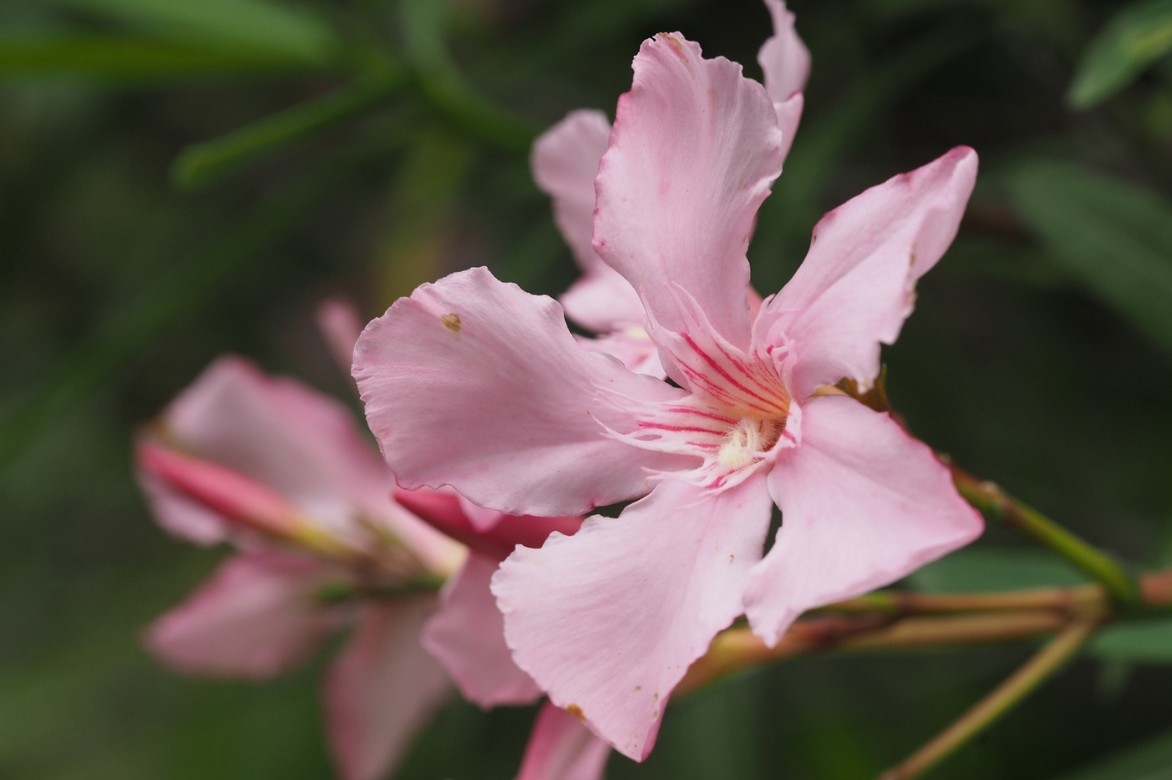
Detail of oleander flower
Description and Botany
Botanical data
- Latin name Nerium oleander
- Family Apocynaceae
- Common name Rose laurel
- Flowering between May and October
- Height between 1 and 5 m
- Exposure sun or partial shade
- Soil type any deep, fresh soil, even poor
- Hardiness Variable (-7 to -16°C)
Nerium oleander is the scientific name of the rose laurel and is the only species in the genus. However, some classifications continue to distinguish the subspecies oleander from the subspecies indicum, which is notable for its highly fragrant flowers and its distribution area extending from Iran to China. Nerium oleander subsp. oleander grows spontaneously around the Mediterranean, such as in Crete or on the Atlas Mountains in Morocco. It is found more sparsely in the northern part of the Mediterranean Sea. Horticultural varieties often result from the cross-breeding of these two subspecies.
The rose laurel belongs to the family Apocynaceae, which includes, among others, periwinkles (Vinca), false jasmine (Trachelospermum), frangipani (Plumeria), desert rose (Adenium), and Allamanda. Common features of all these plants are the evergreen foliage and 5-petalled fused flowers that form a trumpet shape and often emit an exquisite fragrance. The white latex rich in alkaloids that flows from the stems and leaves at the slightest injury confirms this affiliation but is not a sufficient criterion. The people of the Sahel used the latex from Adenium to poison arrows for hunting jackals or hyenas. Legend has it that Napoleon’s troops became intoxicated by cooking lambs with rose laurel wood. It is true that all parts of the plant contain a powerful cardiotonic: oleandrin.
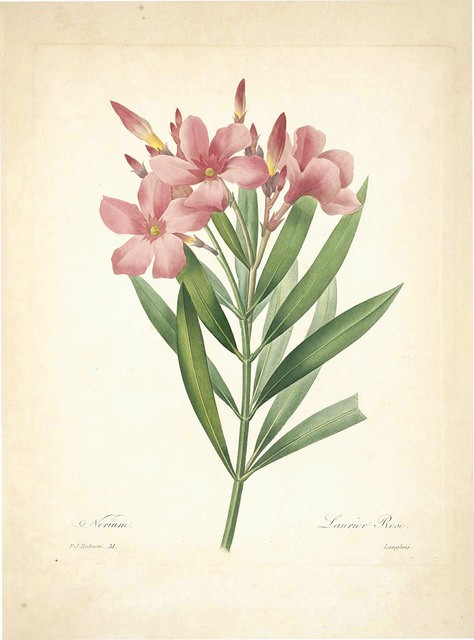
Nerium oleander – botanical illustration
Rose laurels naturally form a bush with a generally rounded bushy habit near the base, with multiple stems that branch upwards. The dimensions of the bush vary from 80 cm in all directions, as seen in ‘Little Red’, to 3-5 m as in ‘Giant of Battles’. The growth is rapid, especially when the plant benefits from warmth and humidity. The young, flexible shoots are smooth and greenish before becoming covered with a thin grey bark.
The foliage of the rose laurel is quite uniform across all varieties, except for a few cultivars with yellow variegated foliage like ‘Variegata’. The lanceolate leaf has a short petiole and a thick, leathery lamina of a slightly bluish green, sometimes light, with a paler underside. They measure 10 to 15 cm in length and 2 to 3 cm in width. The bush retains its leaves all year round, but they can sometimes be scorched by frost, turning greyish. If the stems have survived, the foliage renews in spring. Otherwise, cutting back dead stems is usually followed by vigorous regrowth from the stump. Intense drought contributes to the shedding of the oldest leaves from the base of the stems.
The flowering period varies according to the climate; it can last 4 to 5 months in fresh soil and if the heat is sufficient. Otherwise, it begins in spring and stops before resuming in late summer. Frost damage can also sometimes delay flowering. The corolla forms an expanded tube 3 to 5 cm in diameter, ending in 5 lobes. It can be double or triple and sometimes releases an intense fragrance. The flowers are grouped in very dense corymbs, mainly at the terminal part of branches aged 1 or 2 years. This nectariferous and melliferous flowering offers a whole palette of colours, from white to red, passing through pink, yellow, and even mauve, followed by the formation of long reddish pods. These burst at maturity, releasing a multitude of small seeds equipped with a tuft of white bristles, dispersed by the wind.
The rose laurel is also famous for the toxicity of the entire plant. The sap has a violent taste, so bitter and acrid that it quickly deters the unwary. Although simple contact is not dangerous, do not confuse it with bay laurel (Laurus nobilis), whose wood can be burned for barbecuing and whose leaves are used to flavour meats.
The genus name, Nerium, is thought to derive from neros, meaning wet in Greek, or from Nerion, derived from Nereus, the sea god of Greek mythology. The liquid element that appears in these two interpretations is likely explained by the fact that wild rose laurel never grows far from water. Its long roots anchor deeply into the soil to draw moisture, even on the slopes of gorges or in the beds of dried-up rivers. As evidenced by the rose laurels growing in the arid regions of the Negev in Israel or the southern Anti-Atlas of Morocco, these bushes offer incredible drought resistance. They are among the few bushes anchored in the walls of ravines alongside Acacia and Retama (a type of broom) facing the desert.

Evolution of the flowering of a rose laurel: flowers and leaves, pods and seeds
Read also
When and how to take oleander cuttings?The main varieties of Oleanders
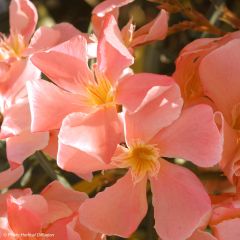
Nerium oleander Salmon
- Flowering time July to October
- Height at maturity 3,50 m
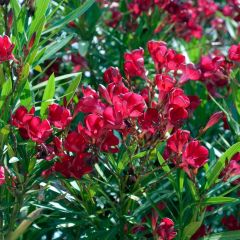
Rose Bay - Nerium oleander Red Single
- Flowering time July to October
- Height at maturity 3,50 m
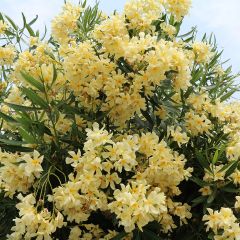
Nerium oleander Yellow
- Flowering time July to November
- Height at maturity 3,50 m
Nerium oleander Roseum Plenum
- Flowering time July to October
- Height at maturity 3 m
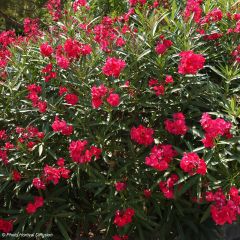
Nerium oleander Double Red
- Flowering time July to November
- Height at maturity 3 m
Discover other Nerium - Oleander
View all →Available in 0 sizes
Available in 4 sizes
Available in 1 sizes
Available in 2 sizes
Available in 1 sizes
Available in 1 sizes
Available in 1 sizes
Available in 4 sizes
Available in 3 sizes
Available in 2 sizes
Planting, in pots or in the garden
Where to plant oleander?
A staple of gardens in the South and along the Atlantic coast of our country, Oleander often ventures further north, thriving on sunny, sheltered terraces, planted in large pots throughout the beautiful season.
Not demanding in terms of soil, drought-resistant, it does require regular watering in summer and appropriate pruning to bloom abundantly. Choose a location that is very sunny and sheltered from the cold, even exposed to sea spray. In warm climates, partial shade is tolerated, although it will be less floriferous and its habit less bushy.
Plant in deep, fertile, well-drained soil, even calcareous or subject to brackish water rise. While it withstands drought very well and adapts to arid conditions, oleander only reaches its full potential and blooms abundantly in soil that is sufficiently cool at depth.
Be mindful of its low hardiness, especially during its early years. A young plant will struggle to regrow from the stump after a severe frost. Protect it with a double layer of winter fleece and a good mulch on the ground.
When to plant?
Nerium is best purchased in full bloom as the labelling is often imprecise. Seek advice to know the hardiness level of the variety. However, it is recommended to plant oleander in spring, when frosts are no longer a concern, in cooler regions, and in early autumn if the climate is warm and dry during summer.
How to plant?
- Soak the root ball in a bucket of water to thoroughly moisten it.
- Dig a planting hole 40 to 50 cm wide or a trench if creating a hedge.
- Add a 10 cm drainage layer (gravel, sand…) if your soil is clayey.
- Add manure or decomposed compost if the soil is sandy.
- Place the plant in the planting hole.
- Replace the soil and lightly firm it down.
- Water.
- Spread a layer of mulch around the base to maintain good moisture around the roots. This will also limit the growth of weeds.
Choose a large pot filled with a mix of citrus tree compost and fertile garden soil or use a potting mix for houseplants that drains well. Place the pot in a sheltered spot during winter, such as a cold greenhouse or a conservatory. If you opt for the latter, ensure your oleander receives plenty of sun and light.

Oleander grown in a pot
Pruning, maintenance, wintering, diseases
Monitor watering in summer during the first two years during hot and dry periods. Watering should be regular during the flowering period, without flooding the roots. Apply it at the base of the plant, never on the foliage. This bush requires no other maintenance apart from light pruning carried out in spring or after flowering.
The oleander is sensitive to cold when newly planted (-8°C), but older specimens generally regrow from the stump after frosts down to -12°C. Always wait for the resumption of vegetation before pruning frozen parts. In spring, occasionally trim the base if the plant appears leggy.
Fertiliser Application
It will appreciate a application of compost and a thick layer of fallen leaves, especially during the first two winters in regions at the edge of hardiness. In pots or containers, the soil depletes more quickly: for significant flowering, apply flower fertiliser approximately every 15 days during flowering.
Repot the young oleander into a slightly larger pot each spring, after trimming the peripheral roots. When it exceeds 1.50 m, repeat the operation only every 2-3 years or top up with potting soil.
Wintering the Oleander
If you live in a mild region where it usually does not freeze below -5°C, you can leave most oleanders in the ground. Otherwise, choose one or more of the following solutions:
- Choose a sheltered spot, such as against a south-facing wall, along a hedge protected from other plants, etc.
- When cold weather is forecast, cover the plant with a double wintering fleece and especially the roots with a thick mulching of fallen leaves.
- Finally, if they are in pots or easily transportable containers, place the oleanders from November until May in an unheated but sufficiently lit room.
Pruning the Oleander
The oleander flowers on the wood of the year. However, pruning requires some precautions. The bush flowers for several years mainly on young branches aged 1 or 2 years but having reached a certain length. If you cut back all the branches, you risk not having flowers that year, especially if the growing season is short.
Annual pruning is optional and should be done in early spring (or late summer if you bring in a pot):
- Remove dead wood.
- Pinch the shoots during spring to remove any remaining fruits and to increase the number of inflorescences.
- Every 3-4 years, remove the oldest stems to aerate the clump, knowing that a stem can flower for several years. A bush that is too dense develops circular brown spots on the foliage due to Ascochita hetromorpha. A cold and humid atmosphere also favours the parasite.
Be careful not to prune the oleander too severely: only stems that have reached a certain length bear flowers!
→ Learn more in our tutorial: How to prune a Laurier rose?
Training a Nerium on a stem
- Select the most beautiful stem on a young plant,
- Place a stake of the desired trunk length, driven in about 30 cm and protruding 1 m or 1.50 m above ground.
- Keep the branching on 1/3 or ½ of the height of the stem.
- Remove all other branches at ground level.
- Continue to remove shoots at ground level and on the trunk while gradually raising the crown to the desired height in the following years.
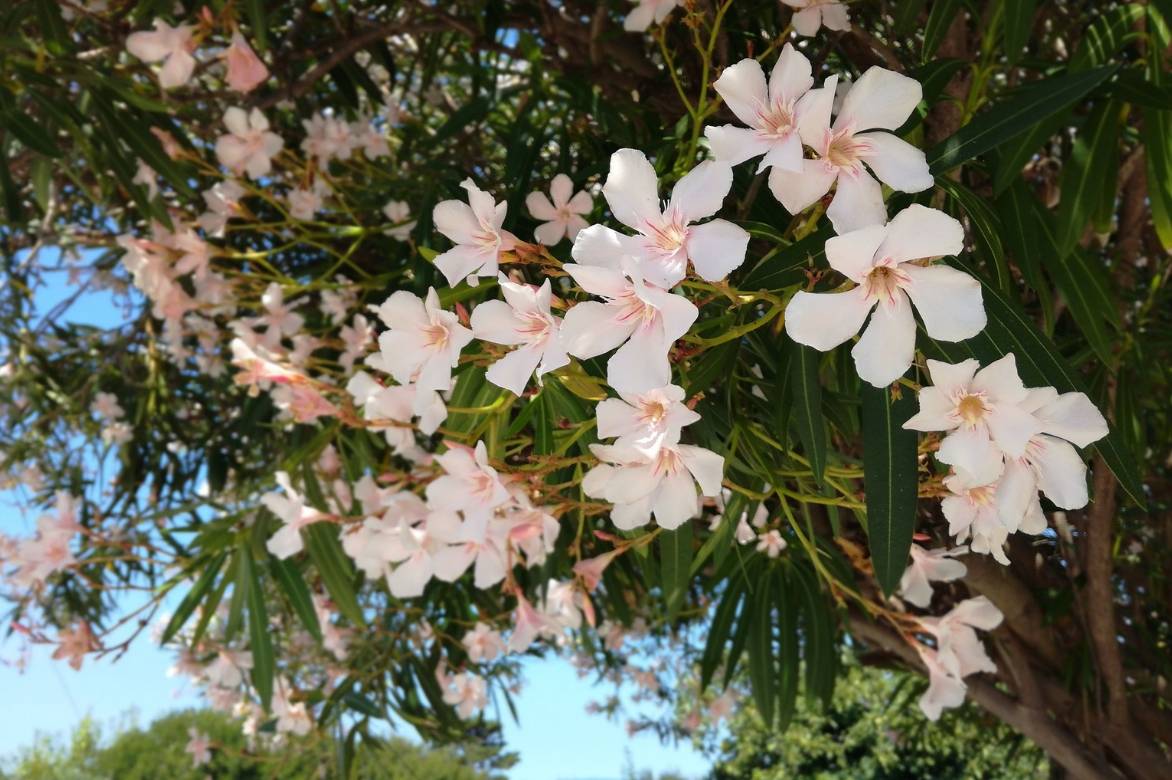
The Oleander can be trained as a tree
Possible Diseases and Pests
Bacteriosis caused by Pseudomonas syringae leads to deforming black cankers, particularly on young branches. It is transmitted by piercing insects or cultural operations. Cut away the affected parts with a well-disinfected pruning shear after each cut and treat monthly for 3 months with Bordeaux mixture. Avoid stress that contributes to weakening the plant.
Attacks from aphids Aphis nerii, followed by black sooty deposits, can be treated with a spray of pyrethrum, black soap, or by encouraging beneficial insects (ladybirds, hoverflies…). Scale insects that form yellow to brown shields along the branches can be treated with rapeseed oil to soften their shells.
The yellow spider appears in overly dry conditions, especially in greenhouses. Regularly mist the foliage.
→ Learn more with our advice sheet Diseases and pests of the Laurier rose
Multiplication: propagating the oleander
Propagation by cuttings in a glass of water is the simplest method for the amateur.
Cutting
- Cut sections of non-flowering shoots from the year, between 15 and 20 cm, just after flowering or at the beginning of summer, preferably in August.
- Using disinfected pruning shears, cut the leaves at the base of the cutting that will be submerged. Incise a few millimetres at this base to facilitate the emergence of roots.
- Soak this base in a bottle of water until it produces a dense tuft of white root hairs. Change the water 1 to 2 times a week.
- Separate the rooted cuttings in spring to plant them in individual pots until the following autumn. Transplant gently into a pot filled with light potting soil to avoid breaking the roots.
- Gradually wean the cutting off water, transitioning from a water-saturated substrate to potting soil that is simply kept moist.
- Transplant into the ground the following spring, or at the end of the following summer in a mild climate.
Uses and associations
In the Mediterranean region, the oleander can be planted in a free hedge as well as in a border.
To create a varied evergreen hedge, you can combine it with the Cherry laurel, Elaeagnus ebbingei, Mexican orange blossom, myrtles, and even Grevilleas. Remember to prune it regularly if it starts to take up too much space. Nerium oleander is an excellent hedge plant for coastal areas.
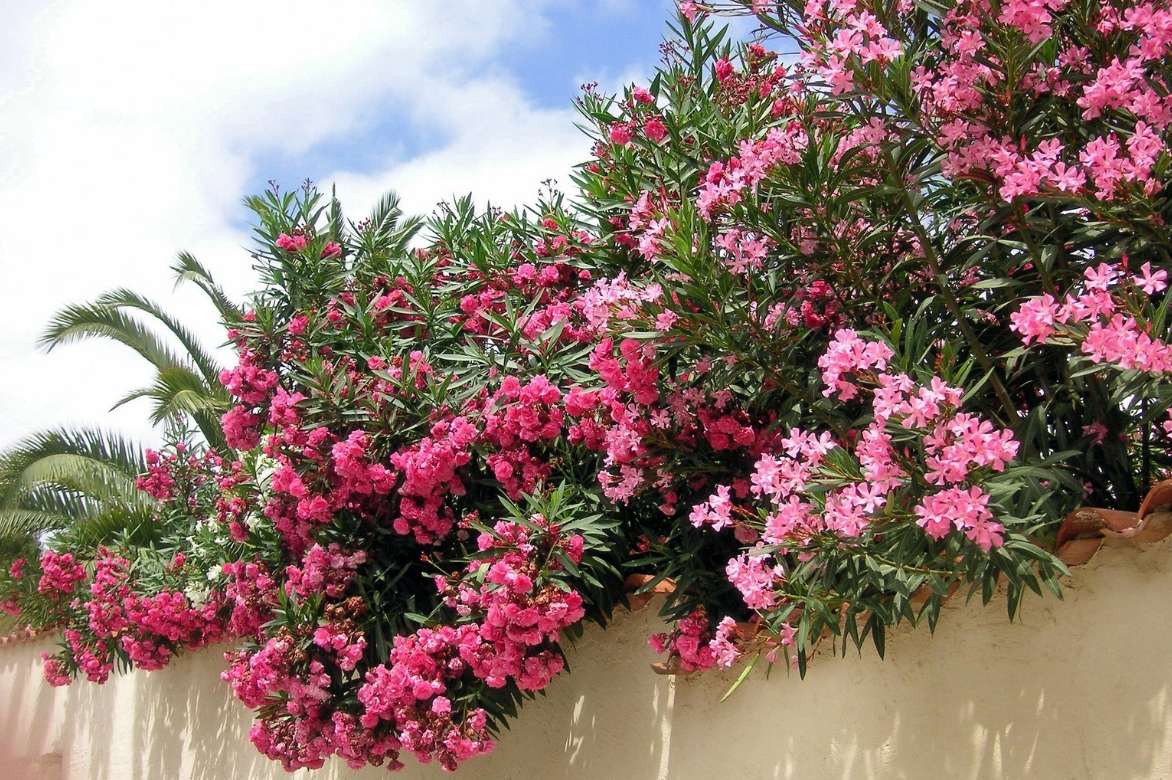
Hedge of oleanders
In a mild climate, it can be trained as a small tree, by initially selecting the most beautiful stem which will be brought to 1.5 m or 2 m above the ground before allowing it to branch out. The resulting specimens are particularly ornamental, but they require a very mild winter that won’t risk cutting them back to the ground: it would be a shame for a severe frost to destroy several years of work in just a few hours!
On the terrace, it will stand in a large pot, alongside citrus trees, Callistemons, Solanum rantonetii, jasmines, bougainvilleas, or palms. This method of cultivation allows the tree to be stored in a very bright, cool but frost-free location during our very cold regions.
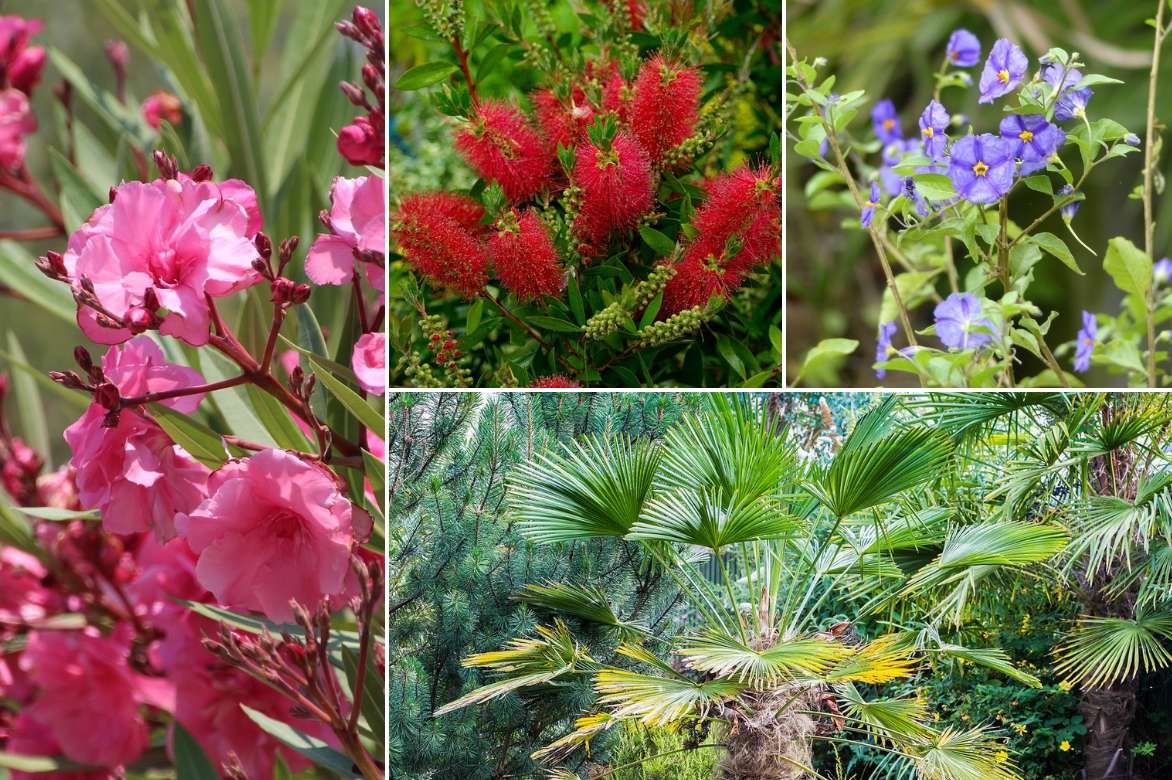
An example of pot pairing on a terrace: Nerium oleander, Callistemon x laevis, Solanum rantonetii, and Trachycarpus wagnerianus
To go further
- Discover our wide range of oleanders
- Learn more about the hardiness of oleanders with our advice sheet: Which oleander to plant according to your region?
- Our tutorial: How to prune an oleander?
- Discover How to create a hedge of oleanders
- Learn more about toxic bushes in our advice sheet
- Discover 10 mistakes to avoid for ensuring a beautiful flowering of oleander
- 8 beautiful ideas for pairing oleander
- Oleanders by colour:
-
- 5 oleanders with pink flowers for an elegant garden
- 5 oleanders with yellow flowers for a bright garden
- oleanders with red flowers: the most beautiful varieties
Frequently asked questions
-
How to treat sooty mould?
Sooty mould is a blackish powdery deposit caused by a non-parasitic fungus that feeds on the honeydew produced by aphids or scale insects. Controlling these sap-sucking insects with black soap or an insecticidal product such as pyrethrin is the best way to prevent it. However, once the leaves are blackened, the solution is to shower the foliage several times and spray with black soap. It is merely a deposit that you can also scrub with a soapy sponge. Optionally, apply Bordeaux mixture to prevent its re-establishment.
- Subscribe!
- Contents
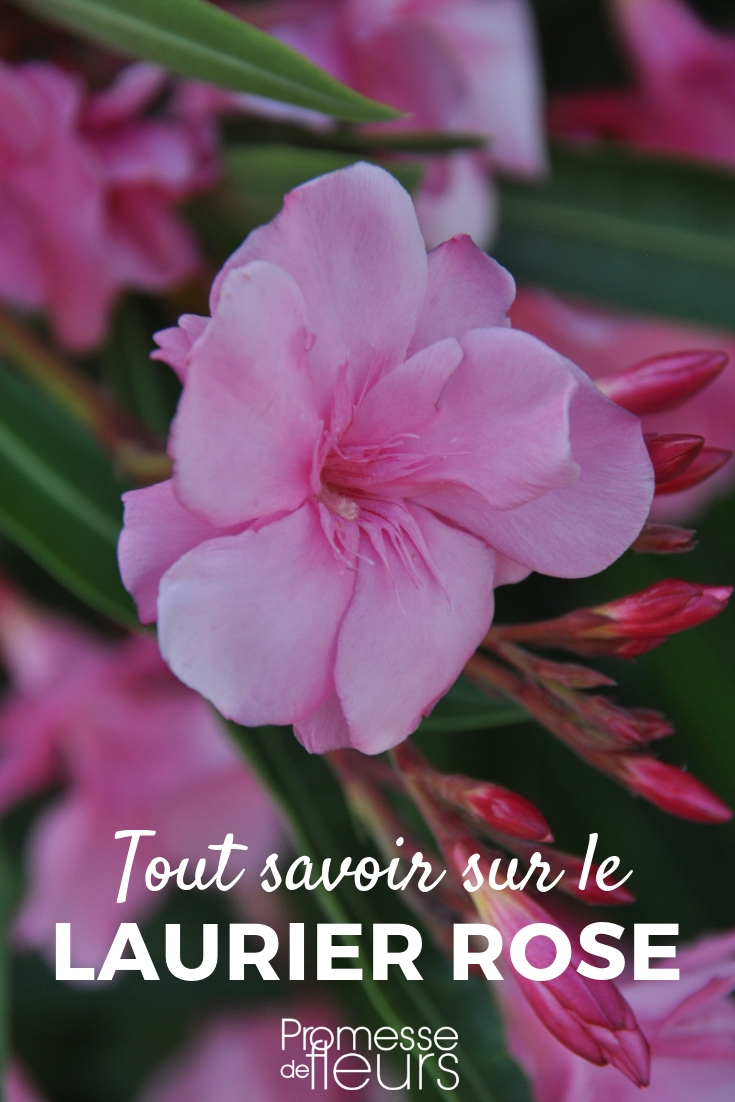































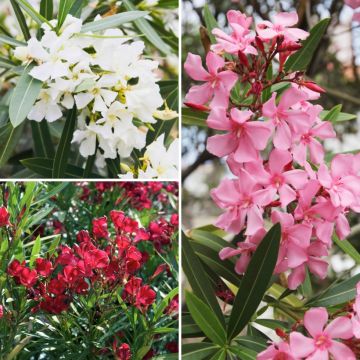
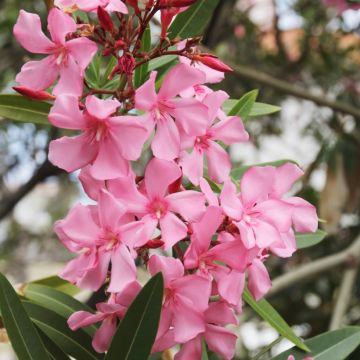
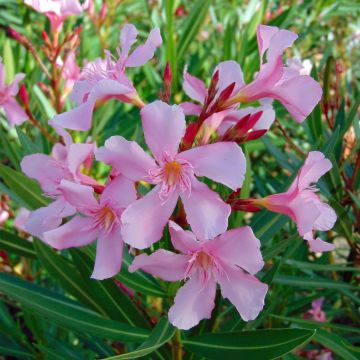
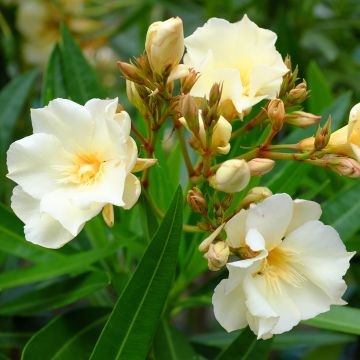
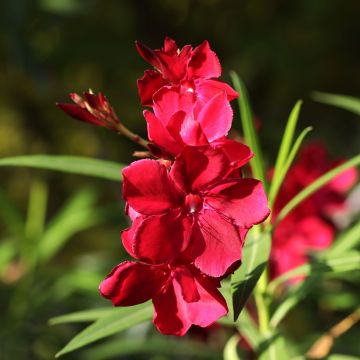
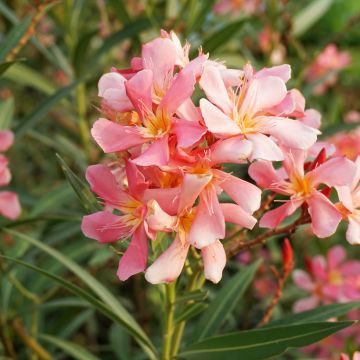
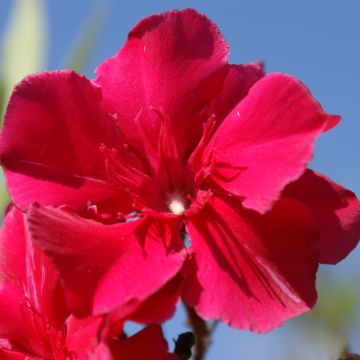


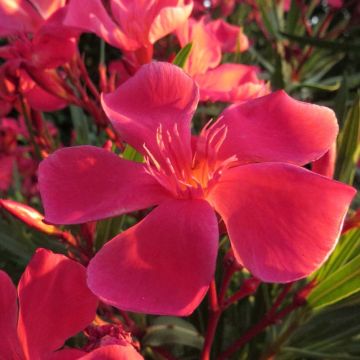
Comments